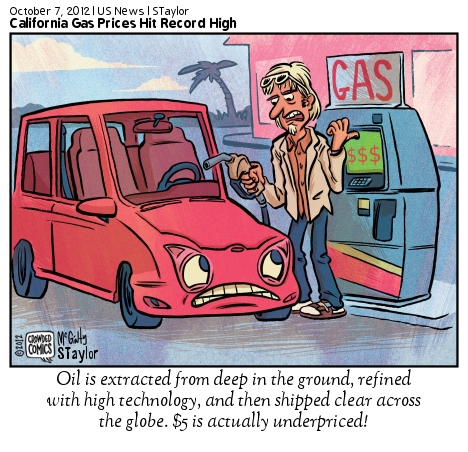Op-Ed: Invest in multipurpose streets to support housing values
8:19 AM PST on January 15, 2013
Municipal bond rates are at historic lows. A memo by two respected faculty members at the UCLA Anderson Forecast (available at Streetsblog, for some reason link to city website is broken) suggests the city take advantage of these low rates to fund a $3 billion program to resurface, rehabilitate, and reconstruct city streets. This same logic extends to any local investment activity - because rates are low, it’s a good time to build or repair anything the city will need in the future. Street repair is an especially good choice for a city experiencing an historically high unemployment rate because a higher proportion of street investment goes into labor and wages than for other investments, a subway tunnel for instance.
While the UCLA Anderson Forecast memo connects street quality and property values, assessing street repair bonds on property tax bills disconnects the payers and the beneficiaries. Although the street improvements, like any increase in amenity value, will be capitalized into slightly higher housing prices, the primary beneficiaries will be drivers who enjoy a smoother ride and reduced vehicle maintenance costs. These drivers need not live in the City of Los Angeles to benefit. Those Los Angelenos who do no or little driving will be assessed the same amount as those who drive fully-loaded Humvees. Even lower income renters who rely on transit and walking will absorb some of the property tax increase.
These are some of the many reasons that policymakers have used user fees to generate revenues for transportation. This century-old system of user fees was born in Southern California. The belief at the time was that asking those who purchase cars and use gasoline to fund roads would be fair and equitable. The gas tax served the transportation system well, until increased vehicle fuel economy and inflation eroded its purchasing power. Californians pay the same nominal tax on a gallon of gasoline as they did in October, 1993. However, a dollar spent on state and local investment in 1993 is only worth 57 cents today.
The City of Los Angeles can’t increase the gas tax, but it can implement other revenue measures that target transportation system users. These measures include:
- an increase in the citywide parking tax charged on private lots
- an increase in citywide parking rates charged on public lots
- cordon pricing - requiring a fee to enter certain areas of Los Angeles. The city can even exempt residents from the fee
- participation in a regional VMT fee, congestion pricing system, or gas tax supplement, with a local return to the city.
Implementing any of these user fees will take years, so the city can’t rely on them to issue bonds today. Even if it did, the revenues from such measures would be far more uncertain than future property tax receipts, translating to higher interest rates and less investment..
One option the city should consider is a hybrid: pursue a property-tax backed street repair bond now in order to take advantage of low interest rates. Later, after the city implements measures to increase revenues from transportation system users, it should use some of these funds to offset a property owner’s tax assessment. The greater the user fee revenues, the lower a property owner’s tax assessment will be. Such a plan creates a large, powerful constituency for a long-term, sustainable transportation finance options, while still taking advantage of historically low interest rates.
Additionally, increasing the marginal cost of driving will make competing modes relatively more attractive - creating additional demand for biking, walking, transit, and increased vehicle occupancy. When investing in its streets, Los Angeles should look forward to serve the future needs of residents who use all modes, not just the historical needs of those who are passing through. That means the bond's expenditure plan must include considerable set asides for sidewalk repair, pedestrian markings, cycle tracks, parklets, and the accelerated implementation of the bicycle master plan. After all, at least initially, it's residents who will be investing in the streets, not drivers. Spending less than 25% of the bond's proceeds on active modes and recreation would be a huge windfall for out-of-town drivers at the expense of Los Angeles residents.
Spending anything less than 25% on such programs ignores Los Angeles's regional competitive advantage as a city with many walkable neighborhoods. A mother with a stroller who can't traverse the sidewalk to a charming neighborhood cafe may be better off leaving the city - especially if she's asked to pay more to smooth roads for out-of-towners who wish to drive to her neighborhood's charming cafe. Those Los Angeles residents seeking smooth streets in lieu of a walkable neighborhood have far more residential choices than someone seeking a walkable neighborhood outside of the City of Los Angeles. Neighborhood walkability is an amenity that few post-war Southern California communities can offer, and walkability is increasingly being capitalized into housing values. The benefits of the set-aside investment will be captured by all neighborhood property owners, not just those who drive.
Juan Matute is a transportation and land use systems researcher at UCLA. He has an MBA from the UCLA Anderson School of Management. He's the Board President of the Southern California Streets Initiative, the non-profit organization that maintains Los Angeles Streetsblog. The opinions expressed in this article are his own, and do not necessarily reflect those of UCLA, Los Angeles Streetsblog, or any other organization.
Stay in touch
Sign up for our free newsletter
More from Streetsblog Los Angeles
Automated Enforcement Coming Soon to a Bus Lane Near You
Metro is already installing on-bus cameras. Soon comes testing, outreach, then warning tickets. Wilshire/5th/6th and La Brea will be the first bus routes in the bus lane enforcement program.
Metro Looks to Approve Torrance C Line Extension Alignment
Selecting the relatively low-cost hybrid alternative should help the oft-delayed South Bay C Line extension move a step closer to reality





